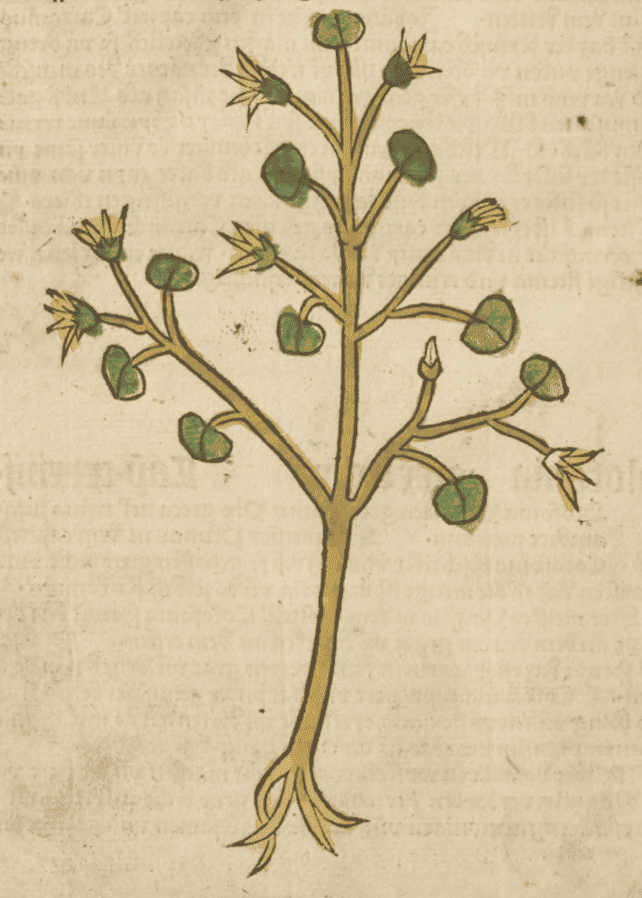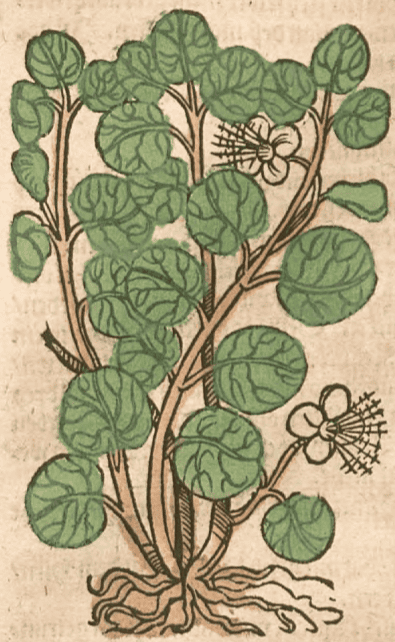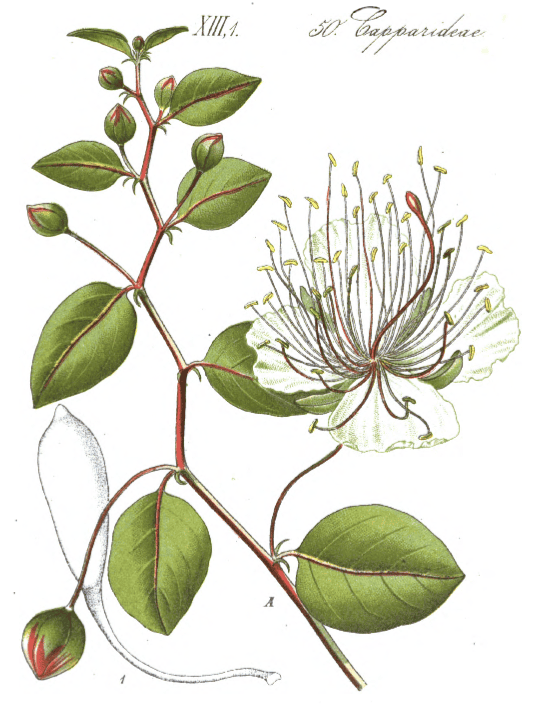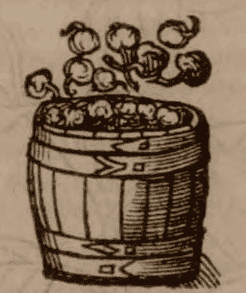Capparum, Capers
Classical western names include: cynosbaton, capria, coracos melon, ophioscordon, ophiostaphylon, petraia, holophyton, aeichloron, hippomanes, trichomanesKarira, Apatra (Ayurveda)
Kabar, Kabar-ul-Hindi (Unani)
Chengan (Siddha)
Lao Shu Gua (TCM)

|

|
|
Gart der Gesundheit, Cuba, 1485 |
Krauterbuch, Lonitzer, 1578 |
 Flora von Deutschland (14), Kohler, 1883
Flora von Deutschland (14), Kohler, 1883 Members CLICK HERE for the PRO VERSION
Members CLICK HERE for the PRO VERSION
Botanical name:Capparis spinosa Round and Pointed Leaf varieties were known Parts used:Root-bark; Caper fruit are mostly used as food Temperature & Taste:Warm, dry. Pungent, Bitter, Sour cuts, opens, cleanses, binds Classifications:2B. ATTENUATERS. 2C INCIDERS 2F. PURIFYING 2J. RAREFYING 2K. RESOLVENT 4f. SPLENETIC |
 Capers, Lustgarten der Gesundtheit, Ryff, 1546
Capers, Lustgarten der Gesundtheit, Ryff, 1546 |
Uses:
1. Clears Phlegm, Moves the Blood, Resolves Swelling:
-all types of Phlegm swellings such as Scrofula, Fibroids;
-Swelling or hardness of the Liver or Spleen; Cirrhosis
-“Its root dissolves Scrofula and other hard swellings” (Avicenna)
2. Clears Damp, Opens Obstructions, Resists Melancholy:
-pain, swelling and hardness of the Spleen
-“the most beneficial drug to be used in hardness of the Spleen” (Avicenna)
3. Clears Wind-Damp, Promotes Urine, Eases Pain:
-acute and chronic Arthritis and Rheumatic Arthritis (TCM); Rheumatism (Salmon); Sciatica
-Edema, fluid retention
4. Moves the Blood, Promotes Menstruation, Relieves Pain:
-Amenorrhea, Dysmenorrhea
-Infertility.
-“Increases Sexual desire” (Avicenna)
5. Resists Poison:
-“It acts as an antidote against Poison” (Avicenna)
6. Kills Worms
-“Kills Intestinal Round-worm” (Avicenna)
7. Externally:
-applied topically to Swellings, Skin Eruptions
-applied to Ringworm, Vitiligo (bruised root-bark)
-bruised root-bark is applied over malignant sores, indolent Ulcers.
-“Application of root bark proves to be extremely useful for treating putrefied and malignant wounds” (Avicenna)
-fruit decocted in vinegar and used as a mouthwash for Toothache (Dioscorides)
-“Biting the root-bark relieves toothache”. (Avicenna)
-extract dropped into the Ears relieves Earache
-“Chewing of its root-bark absorbs ‘moistness’ from the Head and relieves cold Headache” (Avicenna)
Dose:
Powder: 1–3 grams
Comment:
… available in PRO version
Corrective:
… available in PRO version

Main Combinations:
1. Melancholy and Dampness of the Spleen, Caper root bark with … available in PRO version
2. Hardness of the Spleen:
i. without Fever, Caper root bark with … available in PRO version
ii. decoct Caper root bark with … available in PRO version
3. Dysuria from atony, Caper root bark with … available in PRO version
4. Oil of Capers, for Hardness, Pain and Swelling of the Spleen, Caper root bark with … available in PRO version
5. Fomentation for Hemorrhoids: Caper root bark with … available in PRO version
Major Formulas
Troches of Capers Root-bark (Mesue)
Troches of Capers Root-bark (Unani)
Troches of Gum Lacca (Trochisci de Lacca) (Mesue)
Troches for Melancholy (Nicholas)
Syrup to Purge all Humors of Frankfurt
Pills to Crumble Kidney Stones (Unani)
Antidotum Haemagogum (Nicholas)
Electuary of Horehound (Diaprassium)
Plaster for Hard Tumors of the Uterus
Cautions:
1. ‘It disturbs the belly, it is bad for the stomach, and it is thirst making, but when eaten boiled, it is more wholesome than raw.’ (Dioscorides)
Main Preparations used:
Compound Oil of Capers, Troches of Capers, Extract of the Root Bark
-
Extra Info
-
History
|
‘This plant is widely distributed, being found in Afghanistan, West Asia, Europe, North Africa, Australia, and the Sandwich Islands. The common Indian and Oriental form, Var. 3 of Hooker’s Indian Flora, grows on the Mahableshwar Hills. Caper bark does not appear to have been known as a medicine to the Hindus until introduced by the Mahometans, but another species of Capparis, C. aphylla, very common in India, and having somewhat similar properties, has a Sanskrit name (Karfra), and its berries are used by the natives. Capparis is mentioned by both Greek and Latin writers, and its medicinal properties were probably made known to the Arabs through them. The Syrian name is Kabar and the Turkish Kabarish; in Persia it is called Kabar and Kiirak. |
The author of the Makhzan-el-Adwiya gives a good description of the plant, and says that the root bark is the most active part, and generally used. He considers it to be hot and dry, and to act as a detergent and astringent, expelling cold humors; it is therefore recommended in palsy, dropsy, and gouty and rheumatic affections; the juice of the fresh plant is directed to be dropped into the ear to kill worms, just as Cleome juice is used in India; all parts of the plant are said to have a stimulating and astringent effect when applied externally. Ainslie mentions the drug as an imported article, and notices its use as an external application to malignant ulcers.’ (Vegetable Materia Medica of Western India, Dymock, 1885) |
